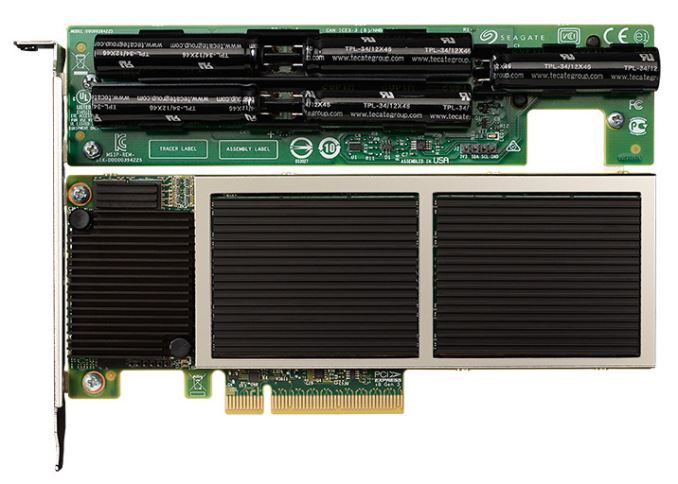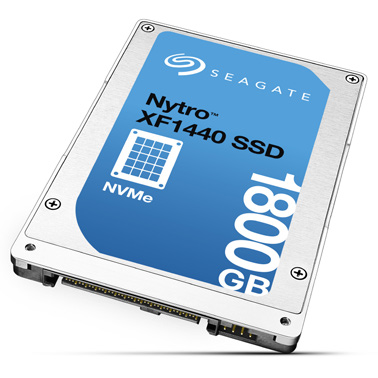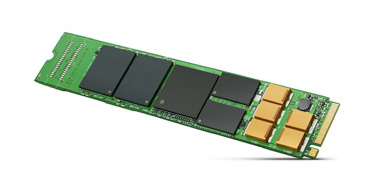Seagate Introduces New Nytro PCIe SSDs: XP6500 & XF/XM1440
by Billy Tallis on August 11, 2015 8:30 AM EST
After acquiring SSD controller designer SandForce, LSI took the quick route towards creating high-performance PCIe SSDs by putting multiple SandForce controllers and an LSI RAID controller on a single expansion card, branding the resulting product as the Nytro. This Nytro product line was transferred to Seagate along with the SandForce division in May 2014, and it's now getting both a refresh and a major expansion.
The new Nytro XP6500 succeeds the Nytro XP6302 and offers improved write latency and improved write endurance. Write throughput suffers slightly, but the XP6302's original performance specifications were inflated by testing at 28% over-provisioning rather than the default of 17% that is implied by the listed capacities. Meanwhile the XP6500 4TB model is listed as optimized for 8kB rather than 4kB random accesses, so its IOPS numbers aren't directly comparable to the others.
| Seagate Nytro XP6000 Series | |||||
| Drive | XP6500 4TB | XP6500 1.5TB | XP6302 | ||
| Usable capacity | 3.4TB | 1.3TB | 1.3TB, 1.75TB, 3.5TB | ||
| Interface | PCIe 3.0 x8 | ||||
| Sequential read | 4 GB/s | ||||
| Sequential write | 2.2 GB/s | 1.5 GB/s | 2.3 GB/s | ||
| Random read IOPS | 275K (8KB) | 300K (4KB) | 296K (4KB) | ||
| Random write IOPS | 85K (8KB) | 100K (4KB) | 148K (4KB) | ||
| Write latency | 14µs | 33µs | |||
| Write endurance | 20 PB | 8 PB | 6.6-11.7 PB | ||
| Required airflow | 550 LFM | 300 LFM | |||
Peak power consumption isn't listed but is likely significantly increased over the XP6302's 39W, based on the increase in required airflow from 300LFM to 550LFM for the same operating temperature range. The Nytro XP6500 supports a supercapacitor bank to protect data in its large (2-4GB) DRAM cache. The XP6500 is available either as a full-height expansion card with built-in supercapacitors, or as a half-height card with an optional tethered supercapacitor module. Seagate has announced immediate availability of the Nytro XP6500.
Expanding the Nytro brand into new territory are the XF1440 and XM1440 NVMe drives, in 2.5" U.2 (SFF-8639) and M.2 22110 form factors respectively. They're split in to two tiers: “Endurance Optimized” (3 drive writes per day) and “Capacity Optimized” (0.3 DWPD).
| Seagate Nytro XF1440 | ||||
| Drive | Endurance Optimized | Capacity Optimized | ||
| Usable capacity | 400 GB, 800 GB, 1600 GB | 480 GB, 960 GB, 1800 GB | ||
| Interface | PCIe 3.0 x4 SFF-8639 | |||
| Sequential read | 2700 MB/s | |||
| Sequential write | 600-1200 MB/s | |||
| Random read IOPS | 200K | |||
| Random write IOPS | 34K | 3K–7K | ||
| Write endurance | 3 DWPD | 0.3 DWPD | ||
| Warranty | 5 years | |||
| Peak power | 12.5 W | |||
| Average read/write power | 9 W | |||
Performance specifications for the Nytro XM1440 weren't available, and we aren't assuming that they will be the same as for the Nytro XF1440. The XF is listed as using eMLC (Enterprise MLC) but the XM is using MLC+, a term often used to refer to higher-binned consumer-grade MLC. Maximum power consumption is significantly lower for the XM, and the XM will be released later (early 2016, when the XF1440 will ship at the end of October), which suggests that there may also be controller differences.
| Seagate Nytro XM1440 | ||||
| Drive | Endurance Optimized | Capacity Optimized | ||
| Usable capacity | 400 GB, 800 GB | 480 GB, 960 GB | ||
| Interface | M.2 PCIe 3.0 x4 | |||
| Write endurance | 3 DWPD | 0.3 DWPD | ||
| Warranty | 5 years | |||
| Peak power | 8.25 W | |||
| Average read/write power | 7 W | |||
Source: Seagate












20 Comments
View All Comments
Impulses - Tuesday, August 11, 2015 - link
You jest, but I'm someone will eventually drop a few grand on something like this just for their Steam library, and then realize it doesn't make much of a difference vs a cheap SATA SSD.Visual - Wednesday, August 12, 2015 - link
What cheap SATa SSD is 3.4TB?Denithor - Tuesday, August 11, 2015 - link
As the saying goes, if you have to ask, you can't afford it...squidsurprise - Tuesday, August 11, 2015 - link
Can we get it compared to other PCIe/M2 SSDs? Like the Intel 750 or the Samsung?darkgreen - Tuesday, August 11, 2015 - link
Are those Nytro XF1440 write IOPS correct? 3-7K random write IOPS vs 230K random write IOPS for the Intel 750? What causes such a huge discrepancy (assuming it's not a typo on one or the other)Billy Tallis - Tuesday, August 11, 2015 - link
Yeah, random writes really are that slow on the models optimized for reads. The capacity dependence is a little weird, though: 6k for the 480GB, 7k for the 960GB, and 3k for the 1800GB. See the spec sheet: https://www.seagate.com/files/www-content/product-...In the enterprise market we're seeing a very strong trend toward knowing your workload and buying a drive that matches your needs. So some of the enterprise drives rolling out are highly specialized and completely unsuited for the client market. Others would be great performers but cost several times more than consumers want to pay.
darkgreen - Tuesday, August 11, 2015 - link
wow, yeah, I guess the tradeoffs can be that great. I did some engineering work years ago on trading off NAND handling properties in a RAID configuration but we didn't run the spreadsheets out to factors of 100x! Now I guess I need to figure out my workloads better, but it's scary to think that the storage hardware choice could leave me stuck in an architectural choice for a few years...marraco - Tuesday, August 11, 2015 - link
When will anandtech review SSD on DIMM memory modules?They are the best ones, and do not require a nvme or PCIe slot.
Billy Tallis - Tuesday, August 11, 2015 - link
NVDIMMs that just work with no special support needed are just RDIMMS with supercaps and enough flash to save their contents on power failure. Their ordinary online use doesn't touch the flash at all, which makes them completely uninteresting from a benchmarking perspective.For true all-flash DIMMs, the only solution out there seems to be from Diablo Technologies and licensees like SanDisk. They were mired in a patent lawsuit earlier this year that kept their chips off the market for a few months.
So there's really only one thing for us to benchmark, and they haven't offered samples and their product hasn't been easy to buy, and our current equipment doesn't support RDIMMs anyways.
YoloPascual - Tuesday, August 11, 2015 - link
But nobody wants to use SSDs.